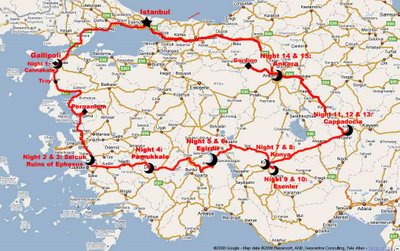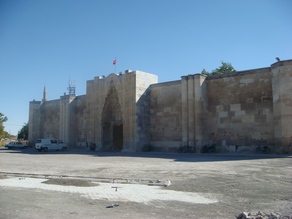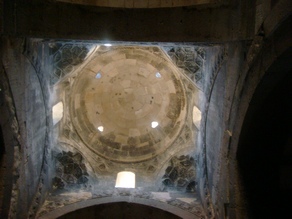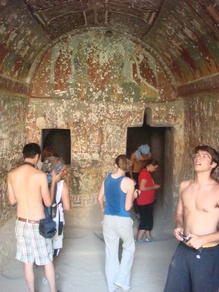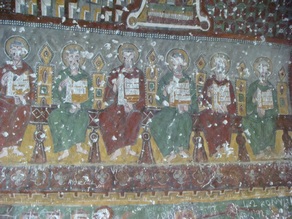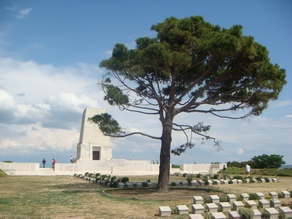Teaching “Active Learning”?
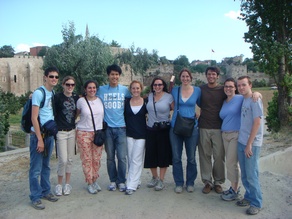
The students left ten days ago. Out the window of the dining car on the Iç Anadolu Mavi Tren, I can see the same Taurus mountains in which we spent time together. I’m returning to Istanbul from Syria. Since the students left, I’ve been thinking again and again about the summer course, about the students, about the whole project of “active learning.”
I was often confused during the seven week seminar. What is “active teaching?” Isn’t all teaching active? And if you are successful in evoking students’ own learning, is there a role for a teacher at all?
I had thought carefully about how to introduce them to Istanbul. I had considered what kinds of ground rules I would to encourage them to make for their dealings with each other. I had hoped to make them comfortable and familiar with the core of Istanbul, so much that they would feel welcome to explore it on their own. And I had assigned a “cultural events” analysis that would require them to leave their apartment and venture into unfamiliar sorts of events.
Did it work? Or should I not have worried about it to begin with? These students were truly remarkable. I came to admire each of them individually, and to marvel at all of them as a collective. They didn’t rest. They worked in the day and engaged with the streets, the cafes, (the bars) at night. There was so much to experience, so little time, they explained. If one is working for “active learning,” and the students learn an enormous amount on their own, is that successful teaching?
The Burch seminars have an innovative design. Faculty and students are expected to explore a topic together. But the university’s expectations for even such an innovative program are rather traditional. I had planned to gather inside a classroom a few hours a day to talk about the readings and our experiences. But there were too many things to experience. The discussion time kept receding into the background as the students kept forging ahead. I kept seeing that they wanted to do many things, but seemed to resist setting aside time to talk about their experiences. Weren’t we supposed to meet and have formal “classes”? We had one difficult discussion on the road to talk about how to schedule both experiences and classes. But it never seemed to work. There were always too many things to see, to do, to learn. In the end, I had to agree. We began to grab whatever time we could. We talked about nationalism, identity, resources, and tourism sitting on the rocks in a beautiful mountain stream. We identified Byzantine iconic representations standing in a cave staring at the paintings. We talked about confusions and reflections over breakfast in a hotel restaurant.
I found that the students had actually been reflecting on all of their experiences–I just hadn’t been around to hear it. They talked in the evenings and at night, listing the things they didn’t understand, the things they really appreciated whether they understood them or not, and the things they had just figured out. (See a list on Emily’s blog.) They posted great photographs and analyzed their days in the blogs they struggled to keep up with. But there was a continuing problem–there would be time to reflect later, but they could only experience NOW!
Sometimes I thought I actually had no role. I set up the course, assigned the reading, planned the introductions, and they did the rest. I still think they were the ones who made the program work. But I hope that my questions–probably much more than my answers to their continuous questions–helped them along the way.
My own reflections from the summer are now focused on the fall. Whatever I did to encourage active learning–should I call it “active teaching”? Is that what keeps students from becoming tourists? Whenever people asked them if they were tourists, they always demurred. No, they answered, we’re students.
From my first visit to Turkey, I was struck by the tourists’ experience. The huge air-conditioned buses that kept them high above the level of the streets took them to the most important monuments and then back again to their western-style hotels. They didn’t ever get to encounter the stuff at street level, have to figure out how to use a squat toilet, taste the local foods, ride the local ferries, see the local poor. They didn’t know about the fascinating and complicated politics, the way children greet their grandparents, or the amazing scenes down by the docks. Tourists live a sanitized existence, free of everything messy but also free of everything fascinating.
Tourists simply sample, never quite engaging local societies, cultures, people. They see the monuments, eat in tourist restaurants, buy the curiosities. I wonder now if that is what the students in my large lecture courses are: tourists. They collect facts, souvenirs of a class that collectively represent the few things they will remember. But they don’t encounter the messy and the fascinating in history, the various ideas that do not connect with each other, the facts that don’t fit together, the big disagreements, the novel ideas and the strange experiences. Like tourists, they expect to be kept from having to grapple with discomfort.
These students were different. They weren’t content to see Hagia Sophia and the Blue Mosque, go to the covered bazaar, eat Turkish food at tourist restaurants and consume “Turkish culture” at special dedicated evening programs. They wanted to interrogate and explore, to laugh with new Turkish friends and celebrate Turkey’s football victories, to figure out how to use squat toilets and which kinds of foods people really liked. They wanted to travel, to experience–to figure it out for themselves. They know a huge amount now about Turkey, they can get around, they know (for the most part) how not to give offense. They have at least a basic knowledge of Turkey’s history, culture, and language. But I didn’t give it to them. They got it.
We’re not tourists, they insisted to any Turks who asked. We’re students. And I think I get it now–they are students, and I need to work harder to make sure the rest of my students stop being tourists.

Farewell Dinner
And for these students, I have nothing but admiration and gratitude. I was simply awed by the way they treated each other and me. I have never seen another ten people who cared so deeply about each other, helped each other so consistently, worked together so well, and enjoyed each other so continuously. They were amazing to travel with. They took on things by themselves, did difficult tasks without being asked, and never complained about less-than-ideal situations. I was quite grateful for their responses, especially when things did not work out; as one explained, if things aren’t OK, we laugh about it. If they are, we are happy. I am convinced I could never again find a group willing to move so many mattresses, share so much medicine, sleep in such close quarters, or stay so completely flexible in order to take advantage of whatever came up.
Thanks to them all, to Mr. Burch and to the UNC Honors program. Thanks also to all those who agreed to talk with them about various aspects of Turkish life and history and culture, who helped them find what they sought. Thanks to Katie, for her ideas with the planning, and to Friederike for her continuous assistance. And, of course, thanks to William, for his insights and support and for being the best traveling companion one could ever hope to find.
Back in Istanbul

We took the night train back to Istanbul. Despite the fact that only half of us slept, everyone was ready to smile for the final “after” photo. It seems we all found our way back to our places and crashed. Two weeks on the road is a long time, especially with people as amazing as these students. They seem to thrive on minimal sleep, have a vast desire to encounter everything and engage with everyone, and manage to maintain their sense of humor throughout. I learned a lot from them, about mutual respect and support, about learning and teaching, about humor and good fellowship. They are an amazing team, and always managed to work together and anticipate anything we might need. (I turned around after 11 pm at the Ankara train station to see Edward coming out of the train one more time to collect the luggage not only of our three ill students–he took care of mine, too!)
We set aside a little time the next day to talk, but most of the week is devoted to their projects and interviews. Our big event of the week was a visit to the US Consulate. Many of the students are interested in public policy and diplomacy, and an old friend who used to work in the Foreign Service helped us get an appointment. We had a number of briefers, who answered our questions clearly and, I think, honestly.
The condition, though, seemed quite odd, considering our recent experiences. This was an “off the record” briefing. That means, apparently, that we cannot relate what we learned or quote anyone. This is a difficult condition for a historian, though it seems quite common and acceptable for journalists. The briefers simply assumed we understood and would accept the condition, and never sought any kind of agreement from us.
Istanbul’s mufti had seemed surprised at our meeting some weeks ago when he was asked if it would be alright to quote his remarks. Of course, he responded. He seemed confused. If he said something, why wouldn’t he agree to having it quoted? The students have received the same response during interviews. If something wasn’t to be quoted, why would the interviewee say it?
I found the condition particularly strange toward the end of the briefing. US officials emphasized again and again American freedom of speech. Yet here we were, unable to quote their words. In Turkey there are many restrictions to the freedom of speech, but people stand by their words.
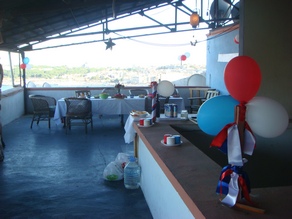
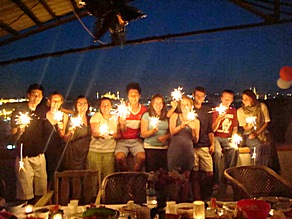
The next night, the students threw a terrific Fourth of July party on the terrace. I’m going to miss the view, too.

Ankara
The bus to Ankara turned out to be a bit more exciting than we had planned. The driver claimed he didn’t know he had to stop in Ankara on his way to Istanbul, so insisted on passing the exits. After a series of phone calls, and some remarkably polite and persistent intervention from Yekta, we arrived somewhere–anywhere–in Ankara and got off the bus. We managed to find four taxis despite the late hour (1:30 am) and made our way to the dorms at Bilkent University.
When our planned speaker postponed the next morning, I offered the students a day off to explore Ankara. Instead, they wanted to go out to Gordion, a site where UNC Classics Professor Ken Sams leads an excavation. After taxi, dolmus, and bus rides, we found ourselves looking up at a mound that had previously been a city.
 I loved Ken Sams’ discussion. We had encountered many guides who provided details about the stones. Ken is a historian. He told us what is known about the people who had lived at Gordion, how we know the things we know about them, and what we don’t know yet. As we stood looking into the stone walls between structures, he told us that the same things had been found in each. These implements provided information on food and textile manufacturing technology, but not why the same things had been found in each room. Archaeologist still don’t know who did the production, and how labor was organized.
I loved Ken Sams’ discussion. We had encountered many guides who provided details about the stones. Ken is a historian. He told us what is known about the people who had lived at Gordion, how we know the things we know about them, and what we don’t know yet. As we stood looking into the stone walls between structures, he told us that the same things had been found in each. These implements provided information on food and textile manufacturing technology, but not why the same things had been found in each room. Archaeologist still don’t know who did the production, and how labor was organized.
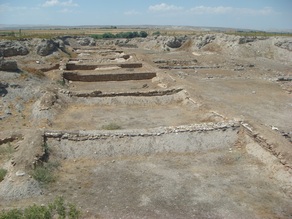 Ken explain to us the kinds of things archaeologists can know, what they wish they knew, why they think other kinds of records may no longer exist. And we learned that archaeologists sometimes revise their previous judgements. We visited the tomb of King Midas. Ken explained, though, that new dating suggested that the corpse was Midas’ father, making it still the tomb that Midas built, but not quite, well, the tomb in which he was buried.
Ken explain to us the kinds of things archaeologists can know, what they wish they knew, why they think other kinds of records may no longer exist. And we learned that archaeologists sometimes revise their previous judgements. We visited the tomb of King Midas. Ken explained, though, that new dating suggested that the corpse was Midas’ father, making it still the tomb that Midas built, but not quite, well, the tomb in which he was buried.
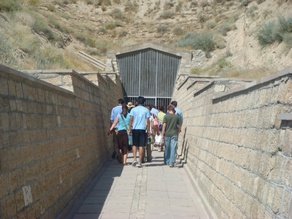
- Into the Tomb
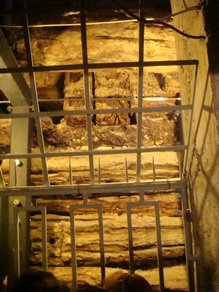
At the small museum next to the excavation, one of the graduate students working at the site explained that the local population had emulated Hellenistic pottery–it was quite the style in some circles. But they didn’t understand some of the Greek pottery’s particular functions, so their imitations are of great interest when analyzing cultural transmission. Ken had talked about the Greeks’ bringing their own languages and customs to Gordion–and to Anatolia generally–but both he and his student emphasized that the local, pre-Greek population remained present throughout the countryside. So what is a “Turk?” It was Phrygians who lived at Gordion–or anyway, it was a Phrygian government who ruled the people. And, it seems, the local population learned from the Greeks, but the Greeks also picked up some of the local customs.
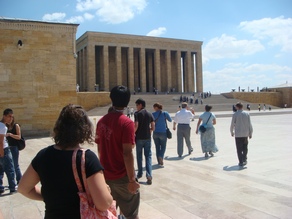
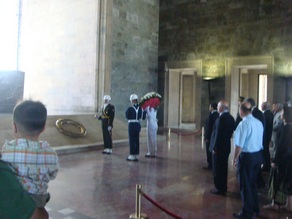
The second Ankara morning was devoted to Atatürk, of course. I got to stay at the dorms with an ill student while William took the students to Anıtkabir, Atatürk’s mausoleum and museum. Their guide was a friend’s father, a retired politician, former cultural minister, and a great admirer of the Founder. After reading of, talking about, and observing the Atatürk cult from afar, the students were able to get right to its center. I am sorry I missed it, but was delighted to hear about what the experience was like for them. (Check out their blogs, links on the right.)
By afternoon, everyone seemed well enough to go to the Museum of Anatolian Civilizations, where Thomas Zimmermann, archaeologist from Bilkent, talked to us about Turkey’s pre-history. He began outside, talking about the buildings themselves, how the project of taking Ottoman hans and turning them into an archaeological museum was an inherently political project. The goal was to claim a distinctly Turkish past, a past that predated the Ottomans, the Seljuks, and even the Byzantines. It reminded me of the new Lebanese state’s efforts to find its Phoenician past, and the nationalist Egyptians’ attempts to claim Pharonic origin. In this case, the new Turkish nationalists used archaeology to trace a very long historical trajectory, claiming that they descended from the Hattas and the Hittites.
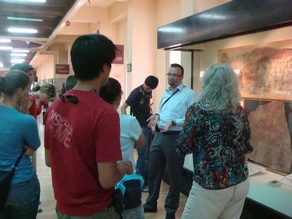
This is an award-winning museum, displayed well and labeled clearly, organized coherently and quite beautifully presented. It creates a linear historical path from pre-historical people to the Turkish present, almost ignoring the Greeks and Romans, who seem to be off limits– invaders instead of true inhabitants of the heartland. I found myself wondering how historians get to choose which groups are authentic and which are outsiders. But in any case, I think the students understand that there is much at stake in the project, more important than memorizing which artifacts go in which era.
Thomas’ fascination with metals was clear–it’s always exciting to have a teacher who is enthusiastic about his work.
Dr. Seuss’ Inspiration?
After a difficult farewell, we returned to Konya in time to meet the Fez bus for the trip to Cappadocia. On the way, they stopped at a remarkably intact Seljuk-era caravanseray. The spiral dome impressed us all.
So did the fascinating collection of heads, another in an astounding collection of Turkish public sculpture we have seen during our travels. Atatürk, of course, is in the center. Those behind him include an enlightening and eclectic collection of Turkish heros: Ottoman Sultans Mehmet the Conqueror and Sulayman the Magnificent, legendary Turkic hero Dede Korkut, mythic Turkic tribal leader Oǧuz Kaǧan, Seljuk Sultan Alparslan, famed architect Sinan, Turkish poet and MP Mehmet Akif Ersoy, and Ibn Sina (Avicenna), medieval scientist and philosopher.
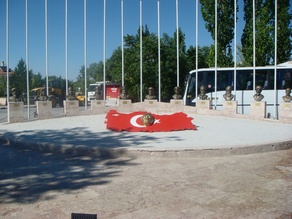
In a few hours, we reached Uchisar, a small town in Cappadocia frequented by French and Italian tourists. The landscape is astonishing, carved by wind and water from the volcanic stone. Over the centuries, humans have helped with the carving, digging homes and public buildings into the rocks. The students insisted on staying in Kilim Pensiyon’s cave rooms.

- View from the Terrace

Landscape by Dr. Seuss?

For two days, we climbed over rocks and explored inside caves, walked along streams and admired the Byzantine churches that still exist around the area. We got to the point that we could actually identify most of the images in the cave churches, images most of us had seen for the first time in Istanbul.
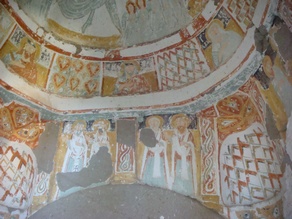
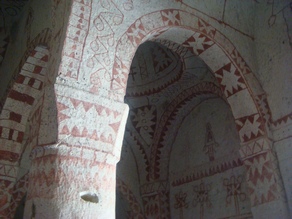
Iconoclast Version
But the walking was intermittently difficult, and the climbing a bit intimidating. After a difficult swim in a reedy, mud-bottomed lake formed inside a volcanic crater, I wondered whether this trip had somehow morphed into outward bound. I sat out the walk along the Ihlara valley, where William and the students explored more caves and admired more churches. I did get to listen in on the conversation in a village restaurant as the owner tried to convince two bureaucrats that they really did need cable and internet -–I was exhibit A, with my laptop and nothing to connect to. (They also wanted to be able to run credit cards, and needed a cable for that. Three months, they were promised.)
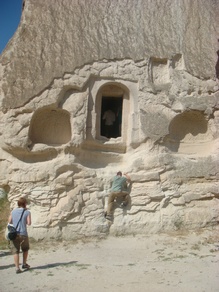
- Outward Bound?
Everyone was a bit tired as we waited to be picked up by the Fez bus for the trip to Ankara that evening. Two weeks on the road is a long time.
Eşenler

Mehmet had grown up in the Taurus mountain village of Esenler, and he offered a home-stay for the group. He had begun this project a few years ago, and the money it provided the villagers helped them upgrade their infrastructure. On the morning of 23 June, his brother Muammer and all the rest of us collected our things and drove in a minibus into the mountains. The village is beautiful, and very vertical, along the side of a steep mountain. We drove to the end of the road, and all of us got out. We piled our things along the side of a small building, and some of the local men covered the stack with some of the rugs lying in a nearby field. (Yes, they appeared to grow Turkish carpets in mountain villages, fields of them!)

Back into the van–they weren’t ready for us, and we had brought a lunch. Another terrific bread, cheese and fruit picnic, this time arranged by our self-appointed Social Chairs. After lunch, it was (of course) up the mountain to explore, then to a cherry orchard to pick some dessert.
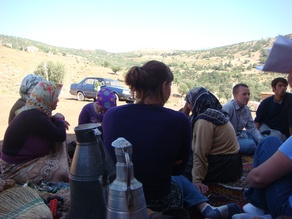
For goal-directed people, a Taurus mountain village is even more frustrating than Istanbul. When we returned to the field of carpets (actually there so that the original bold colors can be faded in the sun, because Europeans seem to prefer pastels), we got to sit and drink tea and talk for what seemed like hours. There was some discussion between Muammer and the men about which students would be hosted by which families, something that had already been worked out (I thought) with Mehmet before we left Konya. At long last, they seemed to be organized and to organize us, and sent students off with families. William and I stayed with two students in a house that was in transition. Normally, a nuclear family of four lived here with their parents. But the younger family had moved out a few days earlier to live next to the field of carpets, and the older couple seemed mostly to be vacating so that the new kitchen cupboards could be installed. This meant that we got to hike up the hill for meals and conversation.
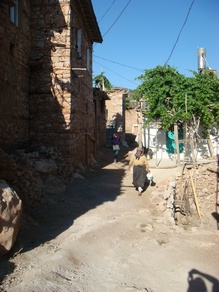
The students loved the experience, by all accounts. Their comments and excitement suggested that the village was not at all what they had expected. Most seemed to be very pleased to be living with their families, and some were quite hesitant to leave at the end of the two days. (Check out their blogs.)
It seems that it was not the specific activities that they enjoyed so much, but the extensive contact. None of the residents spoke English, which helped them use their Turkish. But the communication issues seemed to affect relationships only in a few cases. After their first few days in Istanbul, with the fast learning curve about food and manners and transportation, the village experience seems to have made the biggest impression. All of our understanding of Turks and Turkish life seemed to need revising.
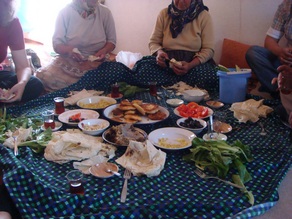
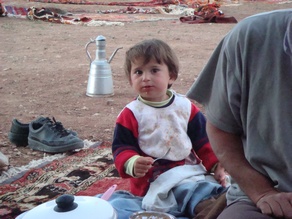
Like dinner the previous evening, we ate breakfast sitting on the floor around a large cloth. The food was terrific, but significantly different from the city (especially breakfast). The students spent some hours the second morning helping pick cherries or pack peaches with their host families. After lunch, Muammer took them for a walk to a local waterfall. That evening they spent comparing notes.
I stayed behind. After more than a week together on the road, it was time for a day off. One of my projects this summer is a book on Turkey aimed at middle school children. This was the perfect opportunity. Needless to say, the text changed as a result of our village time. Like most Turks, I think, I had assumed that Istanbul/Ankara life was Turkey. Amazing how two days can change all that.
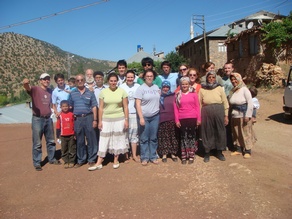
A Four Mosque, Two Museum Day
We met the Fez bus for the ride to Konya. Their staff and the driver agreed to a short stop at the Seljuk mosque in Beyşehir on the way. I got to take the microphone and explain to the students–and the others–why the mosque was important. Eşrefoglu mosque is one of the oldest standing wooden mosques, built around 1229. It also functioned as an observatory, the water in the central courtyard was open to the sky, allowing people to watch the movement of the stars and the moon. Astronomy was important for medieval Muslims, initially to indicate days and times of prayer, but eventually simply as scientific exploration. The mosque’s wooden columns and capitals are beautiful, and the tile is that Seljuk blue so different from the blue of the Blue Mosque and other Ottoman monuments.

We arrived in Konya, called our friend Mehmet (owner of a carpet shop, Ipek Yolu), and he brought his pick-up truck to carry our luggage while the students walked to his shop. After we checked in to the hotel around the corner and had lunch, Mehmet drove us around Konya. He not only sells carpets, but has also worked to reintroduce natural dyes to the local producers. First stop was to the home of one of his weavers, a very experienced woman who has been making kilims for him for decades. Pay is $80/square meter, which provides a significant supplement to the family’s income. We saw her weaving a Navajo kilim–another of Mehmet’s new projects. As those of us who have traveled in the American southwest can attest, Navajo blankets and rugs have gotten quite expensive. Mehmet’s weavers are now producing traditional southwestern patterns for sale in Santa Fe.


Next stop was his own dying shop, where he explained the process by which he has tried to match the colors of antique carpets using plant material. The vats are in a large garage, the dyed wool skeins hanging out to dry in the yard. He showed us a terrific old carpet that desperately needs restoring. He unweaves very old undyed kilims to match the old wool, then dyes them to match the color of the antique carpet. An experienced rug knotter will take his wool and restore the antique.
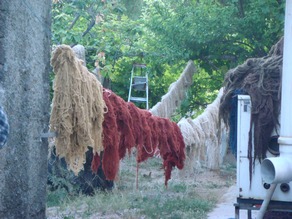
The students were fascinated with the details of weaving, dying and restoring, but some appreciated even more the drive around Konya’s residential neighborhoods. They noticed that very poor households were located in the same neighborhoods as more affluent families, and they enjoyed chatting with the children and petting the cats.
Our second day was the mosque/museum day. Mehmet’s younger brother Muammer was our guide, as we began a day of the kind of intensive high-cultural tourism we hadn’t done since we left Istanbul. I found myself wondering again what the goal of this kind of day is. Is it just exposure to new kinds of things? Some kind of mosque-appreciation project? Museums can be either hours of discovery or bored slow-paced strolling from cabinet to display to statue.
First, it was a 17th century mosque, like a classical Sinan-style mosque updated to baroque. They made the comparisons, got the differences. Then we went to the tomb and attached mosque of Şemsi Tebrizi. There is some dispute about whether Rumi’s teacher is really buried here, and the circumstances surrounding his death. What is certain, though, is that many people see this as a very holy space. The students were impressed with the intensity of feeling displayed by at least one of the visitors–an intensity that Muammer insisted would not have been approved by Rumi himself.
Our third mosque of the day was the central mosque of the Seljuk Sultanate of Rum, Alaeddin mosque. It is an odd structure, expanded over time as more and more people had to fit inside. The blue-tiled mihrab is striking, as is the intricately carved minber. Most striking is probably the forest of columns and the apparent lack of planning for the whole structure.
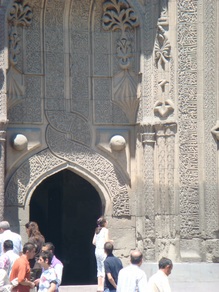
Museum one of the day was full of Seljuk-era wood and stone carving. I knew that Konya was an important city on the old silk road. Nonetheless, I was surprised to see the carvings of lions and elephants, and even more astonished with the Seljuk carving of the Buddha.
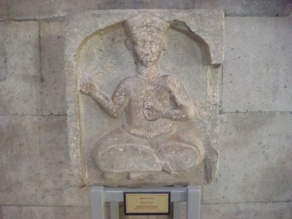
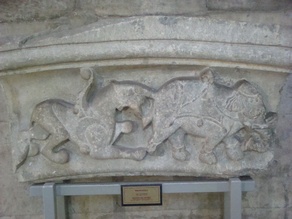
How would the Seljuks have know to carve elephants? I tried to take the opportunity to reiterate the importance of this region for international trade. We left the museum and hurried many blocks to the tile museum, but it was closed for lunch, so we decided to do the same.
After lunch was the big event of the day. Mehmet had arranged for a local historian to take us to the Mevlana “museum.” Mevlana is the name by which Turks know the best-selling poet in America, the man we call Rumi. The government of the young Turkish Republic outlawed sufi orders, worried that they might become alternative bases of authority. They have turned Mevlana’s tomb, a site of pilgrimage and devotion, into a museum, but a museum in which half of the people are engrossed in prayer and half file through with little understanding of what the building is about.
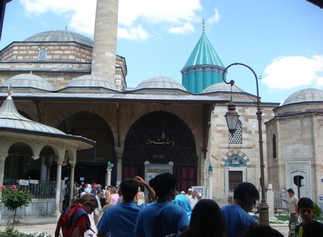
William and I had been there before, and were struck once again by the intense religious environment that the government was unable to displace when it turned the site into a museum. The mosque/museum tourism day seemed to rise to a whole new level of ambiguity at Rumi’s tomb–the line between the two genres erased more dramatically than it had been even at Hagia Sophia. The tekke in which new members of the order had studied now contains displays of the ways the young students lived, and the devotional turning ceremony has become folkloric dance. The crowds of visiting Turks were here to make a pilgrimage; the crowds of foreign tourists looked quite silly wearing leapord-spotted wraps to cover their shorts-clad legs. It was an odd combination.
Our guide, the local history teacher, seemed, like everyone else in Konya, to have his own narrative about and relationship to Mevlana (Rumi). He claimed that Şems was not Mevlana’s teacher–apparently, it seemed important to him that Rumi come up with his own ideas without anyone else’s help. Muammer was convinced that Rumi was a rational man who emphasized rational discourse and thought and would have profoundly disapproved of the kind of emotional intensity we had seen in the morning. For the religious, he is a spiritual leader and a lover of God. For the secular, he is a notable reformer. For the outsider, he is the teacher who insisted on including all. The “museum” experience of reading and listening to the significance of each object and the way the building was created seemed to detract from the human experience of just simply noticing the feelings of the place and the way people responded to it.
One more mosque on leaving Mevlana: a 19th century structure with large windows and ornate minarets, a mosque that seemed to emulate Dolmabahçe’s style. Very modern, European. Enough mosques! We had seen an impressive range of dates and styles over the course of the day.
We got cleaned up and went to a “traditional” restaurant serving local foods. We ate sitting on the floor around round trays, having no idea that this was to be good preparation for our next journey, to the village.
(Can’t resist another in the continuing McPhotos series) 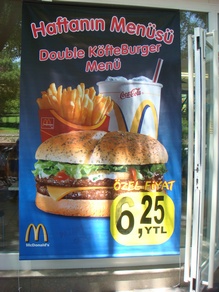
Walking the King’s Road
Pamukkale to Eǧirdir was on a public bus, larger and more comfortable that what we had taken so far. It was much more conducive to sleep. I think these students need bus rides to sleep–they seem to be awake all the rest of the time.
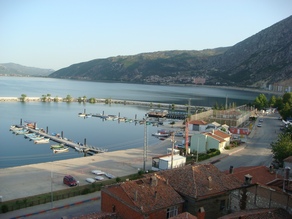
Eǧirdir sits on a large inland lake and is surrounded by spectacular mountains. It is on the way between places, which was our interest in coming. It sits close to the King’s Road that stretched from the Aegean to Persia in the fifth century BC. The Persians used the road for trade, Alexander the Great’s troops marched along it to conquer Darius II, and Paul walked it in his efforts to create converts. We arrived late in the afternoon, talked about Egirdir and history, then the students swam and we all explored the town and its neighboring islands.
 The next morning we went to one of Turkey’s national parks to walk part of the ancient road, now called “Yazılı Canyon,” or “with writing.” We looked at the Greek inscriptions on the hillside–and swam in the beautiful mountain river that created the valley. The setting is spectacular, the water is the sort of “mountain stream” that companies bottle and sell. The students seem always to be drawn to high places, and they followed their passion onto the rocks, from which they jumped into the ice cold water.
The next morning we went to one of Turkey’s national parks to walk part of the ancient road, now called “Yazılı Canyon,” or “with writing.” We looked at the Greek inscriptions on the hillside–and swam in the beautiful mountain river that created the valley. The setting is spectacular, the water is the sort of “mountain stream” that companies bottle and sell. The students seem always to be drawn to high places, and they followed their passion onto the rocks, from which they jumped into the ice cold water.
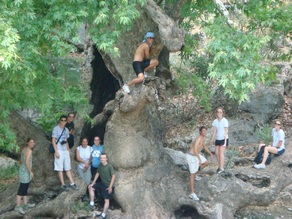

We were delighted to have the park to ourselves, but spent some time on the rocks talking as we dried off. What does it mean that no one was at the national park? Our own national parks are being inundated with tourists, crowded to the point where their resources are compromised. Where do Turks go for vacations? To whom does the Tourism Ministry direct itself? What is the role of tourism in creating a national identity?
As always, the students’ questions and comments were fascinating. Turkey seems to have a two-track tourism effort. For Turks, tourism is about recreation and about education. There is a pass costing only YTL 20 that allows Turks into all major historical and natural sites (unavailable to foreigners who pay admission fees everywhere.) For foreigners, tourism TV ads on European stations emphasize the exotic, the erotic, and the ancient. They left me considering whether, indeed, Turkey’s efforts to present herself as exotic to lure European tourists can possibly be reconciled with her attempts to portray herself as modern and eligible for EU membership.
Pamukkale
We were all sad to say goodbye to the guesthouse and Ephesus. We had had a terrific “day off,” and most of the students slept on the bus to try to catch up!


Pamukkale was the next stop. It is named after the white calcium cliffs that rise above the town. Its waters have been considered good for healing for centuries, and many before the Romans had built on top of the cliffs. After years as a major tourist site with a number of five-star hotels at the top, the UN declared the spot a World Heritage Site, insisted on removing the hotels, and revised the water supply so that the calcium-rich water continued to build up and repair the previous decades’ damage.
It is amazing to climb the hillside. It looks glacial, and I expected that, when I took off my shoes (required), my feet would be in icy water. It looks like ice, but feels quite warm. People played in the pools all the way up to the top, where a swimming pool beckons. You can “swim among the ruins,” the pillars and capitals and various ruins in the warm-water mineral-which swimming pool. Needless to say, the students swam.
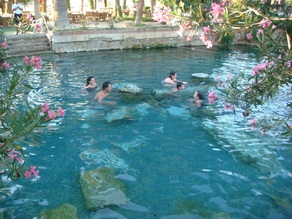
Before we headed up, I had provided a background to the site and to Hierapolis, the ruined city at the top of the hill. After the swimming pool closed, we walked to the Temple of Apollo and the Plutonium. I’d prepared information about six major buildings at the site, but the third was a theater with a stunning view of the countryside below– and a fantastic sunset. They climbed around the theater until it was dark, looking for the images I had asked them to find and enjoying the remarkable setting.
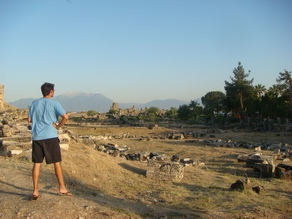
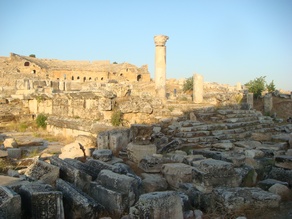
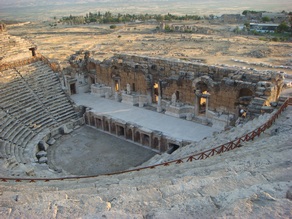
Needless to say, it was difficult to leave Pamukkale, too. I’ve never encountered a group like this. Each evening since we left Istanbul, they have declared it the best day yet. It’s hard not to be enamoured of that kind of attitude!
Ephesus
Our first two days had been grueling, and it had followed some very busy and intense final days preparing for the trip. Every seat on the Fez bus had been full, and none of the 27 seats had been very comfortable. Five hours of battle and battlefield descriptions had delighted only a few of us. The focus on details at the ancient sites had left many confused. The sun was hot, all of us tired, so we offered to let the students sleep late and spend a couple hours at the beach. They hadn’t had any days off in a long time!
We listed the things we could choose from in the area the next day, and asked them to decide what they wanted to see around Selcuk and Ephesus. They produced a schedule that began at 9 am and continued until 10 in the evening. I was impressed!
They were actually ready at 9 in the morning. The first stop: the house where the Pope confirmed that the Virgin Mary spent her last days. This is a small house on a beautiful hillside overlooking Ephesus. We followed a tour group from Italy into the small house. The students’ reactions were varied. Some were clearly touched by the devotion they witnessed, some by their own devotion. Most had never seen anything like the wall to which people were attaching their written prayers.
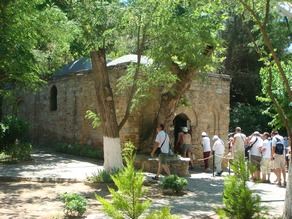
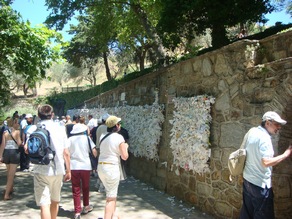
Then it was down the hill to Ephesus. As a historian, I am painfully aware of my own limitations. I’m always hesitant to repeat “general knowledge,” recognizing how inaccurate it often proves in my own field. So I had welcomed the notion of a tour guide, someone who knew the history of the places we were to visit.
But after three guided tours, I realized the the guides didn’t actually know the history of these places, either. They knew the details of the site. They couldn’t provide context, couldn’t describe the bigger picture, couldn’t explain the importance. I was missing the details, which I had thought were what I really needed to have to talk about these sites. But I realized that the details alone were not enough. And we had alreadt learned to ignore the tour guides. It was time to experiment.
I gave myself a crash course on Ephesus and the way the city grew and changed and moved and adapted to the varied challenges to its population. I did a 15-minute background, then turned the students loose in the most remarkable ancient city I’ve had the good fortune to visit. Clearly, this was not enough. They got the background, but that didn’t help them navigate the city. I walked out of the site again, bought a few copies of an inexpensive book explaining the ruins, and distributed them.

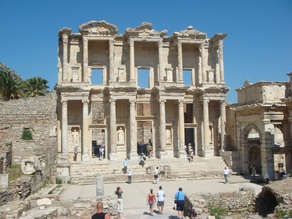
This group is very bright, extremely motivated. With the help of the map and a few of the descriptions, they did a great job showing themselves around Ephesus. They had a broader context, a map to help them figure out where they were, and the details if they wanted them. Nonetheless, I had a sense that I hadn’t provided all they needed. (How much should I provide?) I still have to work on combining teacher and tour guide. Maybe there is something between providing basic background and providing overwhelming detail. I think next time I would send them with a set of questions to find answers to in the ruins.

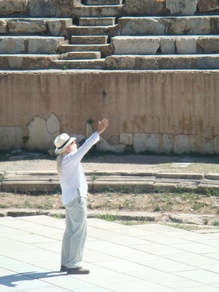 William orating
William orating
The day continued at their pace. The Ephesus museum followed the site visits, then lunch with a friend of Emily’s family in the beautiful garden of a carpet-weaving school. We talked with one of the owners. They bring girls from the nomadic villagers to teach them to weave (why do they need to be taught in the city?). The course takes 40 days, after which each girl is given a loom and sent home. I asked whether the girls could then sell only to this establishment. No. Why do they? The owner answered that he pays the girls directly, not their fathers or their brothers. That keeps them coming back to sell to him.
I took a “break” (gotta research the next site!) while William and the students went to Pamucak beach nearby. Ephesus used to be at the coast, but persistent silting was one of the reasons for its demise. Now the beach is 7 kilometers away, and provided a wonderful (cooling!) outlet for the students’ boundless energy.
After a very short time back in the pensiyon, we went up the hill to the “Greek” village at the top. We wandered the streets, tasted the various fruit wines, talked with some of the residents, and tried to figure out whether there were any Greeks left, and what Greek might mean in this context.
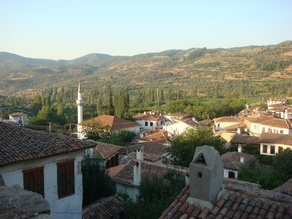
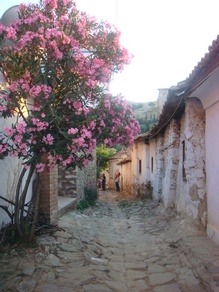
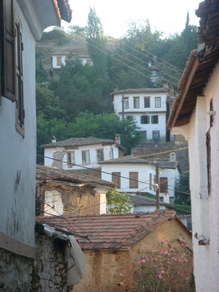
A Day Off, UNC-student style!
New Stones and Old Stones: Narrating Turkey’s Past
Yesterday it was Gallipoli, today Troy. The tour of Gallipoli took five hours, a very detailed recounting of landings and trenches, battles and bad judgment, famine and disease. The story was told by our Turkish tour guide with a remarkable focus on the British, Australian, and New Zealand forces that had struggled to take the Dardennelles in 1915. The narrative was about their plans, their decisions, their suffering, even their dead. We visited the Allied landing sites, the Allied cemeteries, the Allied memorials, and heard detailed accounts of annual Anzac Day celebrations.
When I found our guide standing alone at the Australian memorial, I couldn’t wait any longer. How do tour guides portray these events and monuments for Turks? I asked. Bülent, our guide (named after one of the chief leftist politicians of the 60s) insisted that he did not do tours for Turkish groups. I asked about what seemed to be a tremendous emphasis on and respect for Turkey’s enemies. He agreed, mentioning Ataturk’s famous quote now prominently displayed at the site. When I mused about whether Turkey might consider the same sort of memorial to Armenians, he deferred. He focuses on Galipoli, and can’t really contribute to the conversation on Armenians.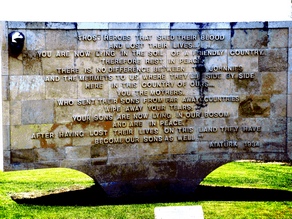
Bülent told me that there are different sites emphasized in tours for Turks, and over the past few years various municipalities had begun bringing busloads of religious Turks to Gallipoli for free tours.
Indeed, we saw Turks at only three of the 9 sites we visited. We saw them at the trenches, the tour stop that illustrated quite dramatically the proximity of the two groups of combatants: the trenches were very few meters apart. Our penultimate stop, a memorial to the Turkish dead, was quite crowded with Turkish busses (from Zetinburnu, Kacamustafapasa municipalities). Bülent explained that the government was trying to turn Galipoli into a pilgrimage site, a sacred space, because of the number of Turks who had died during the battles there. Indeed, the place has become an open-air mosque, complete with a fountain in the courtyard and a mihrab inside the inner walls.
Turks were also predominant at the highest site, where Mustafa Keml (Atatürk) had seen the Allied landings and urged his troops to great sacrifice in order to stop it. The Turkish tour guide was speaking to his audience in the shadow of an enormous statue of Atatürk.
In my Modern Middle East lectures, I often present Gallipoli as a prequel, Ataturk’s life before he took off his Ottoman uniform and joined the opposition to the Allies and the Sultan in 1918. According to many of the people we have spoken with, and a fascinating article by Esra Ozyurek, the renewed reification of Ataturk is largely a response to the growing power of Islamist politics. Although the five other fundamental principals of Kemalism may be eroding, secularism seems to be keeping center stage. Too bad I missed the photograph of the two high-school girls wearing the “turban” headscarves so offfensive to the Kemalists. They were leaving the area of the trenches using a Turkish flag as a shawl.

As the Fez bus wound its way from Çanakkale to Selçuk the next day, we stopped for tours of much older stones than those memorializing the World War I dead. First stop, Troy. Our tour guide provided a photo opportunity to see the Trojan Horse that Brad Pitt had touched (!), retold the mythology of the Illiad, and walked us through the myriad levels of “Troy.” He was more than a bit confusing, apparently unable to distinguish between myth and history, or even to comment on the extent to which myth had influenced our perceptions of history.
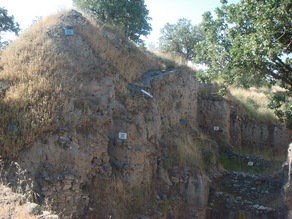
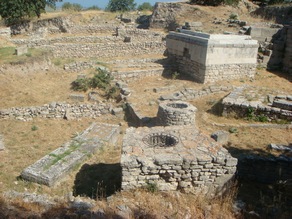
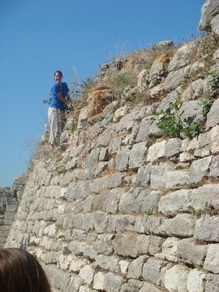
This was antiquarianism of stones, and some of his explanations seemed most unlikely. The high point of the stop was Zoe climbing the walls of Troy (the Turks don’t keep people off many of the ruins).
From Troy, to Bergama (Pergamum), another set of ruins, this one much more convincing. This was the only female tour guide I have seen in Turkey so far. She did a better job, at least explaining how the city had functioned, and where things were located. She paused for reasonable intervals to let us climb around.
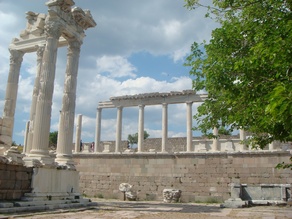

The views were awesome–it is located high on a hill–and the students immediately took to posing. They were particularly delighted with the columns, and decided to retake their “senior pictures” leaning on real pillars instead of the photographers’ substitutes in their home towns.
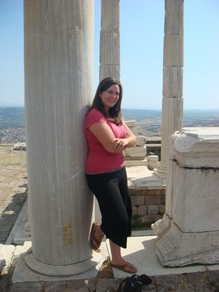

What had all these to do with “Turkish” identity? How do today’s Turks incorporate all these stones into their own collective memory? The only clues we had was a statue defining Homer as an “Anatolian.”
By the time we arrived in Selçuk, I realized that tour guides would not give us what we wanted. Stones are fascinating, but we wanted to know about who had built and lived in them.
